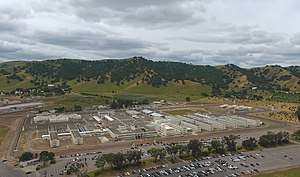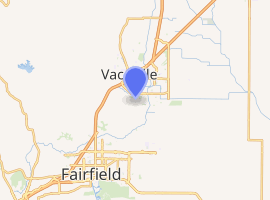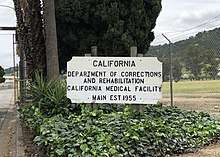California Medical Facility
California Medical Facility (CMF) is a male-only state prison medical facility located in the city of Vacaville, Solano County, California. It is older than California State Prison, Solano, the other state prison in Vacaville.
 | |

| |
| Location | Vacaville, California |
|---|---|
| Coordinates | 38.329°N 121.980°W |
| Status | Operational |
| Security class | Minimum to medium |
| Capacity | 2,361 |
| Population | 2,396 (101.5% capacity) (as of April 30, 2020[1]) |
| Opened | 1955 |
| Managed by | California Department of Corrections and Rehabilitation |
| Warden | Robert Fox |
Facilities
CMF's facilities include Level I ("Open dormitories without a secure perimeter") housing, Level II ("Open dormitories with secure perimeter fences and armed coverage") housing, and Level III ("Individual cells, fenced perimeters and armed coverage") housing.[2]
With a "general acute care hospital, correctional treatment center (CTC), licensed elderly care unit, in-patient and out-patient psychiatric facilities, a hospice unit for terminally ill inmates, housing and treatment for inmates identified with AIDS/HIV, general population, and other special inmate housing,"[3] it is known as "the [California] prison system's health care flagship" and "has many of its best clinical programs."[4] CMF has the largest hospital among California prisons.[5] Furthermore, "the Department of State Hospitals operates a licensed, acute care psychiatric hospital within CMF."[3]
In 2005, CMF had 506 medical staff positions (many of which were not filled) and a health care budget of $72.3 million.[4] As of Fiscal Year 2006/2007, CMF had a total of 1,853 staff and an annual budget of $180 million.[3] As of September 2007, it had a design capacity of 2,179 but a total institution population of 3,047, for an occupancy rate of 139.9 percent.[6]
As of April 30, 2020, CMF was incarcerating people at 101.5% of its design capacity, with 2,396 occupants.[1]
History


CMF opened in 1955.[2]
Among other programs at CMF, the Volunteers of Vacaville began in 1960 as a cooperative effort between the community, staff, and inmates.[7] Inmates who participate in the Volunteers of Vacaville's Blind Project create audiobooks, transcribe books into Braille, clean and repair Perkins Brailler machines, and resurface eyeglasses.[7] The initial goal of this organization was to transcribe books onto audiotape for the blind community outside of the prison. The Blind Project has since grown into a nationally and internationally recognized leader in blind services.[8]
In 1984, the California prison system's first AIDS case was treated at CMF,[9][10] and later the system's first specialized AIDS facilities were developed there.[4]
In the late 1980s and early 1990s, the quality of medical care at CMF was found to be lacking, as evidenced by the following:
- After an investigation, the United States Department of Justice sent a January 1987 letter to then-Governor George Deukmejian stating that CMF "deprive[s] inmates of their right to be free from deliberate indifference to their serious medical needs."[11]
- A 1988 lawsuit charged that CMF was "a filthy, vermin-infested, overcrowded prison," and that medical care there was "grossly inadequate."[12] Although at the time "all inmates in California prisons" with HIV/AIDS were sent to CMF, the suit claimed that "overcrowded housing and medical conditions in the AIDS wing are worse than in the main prison."[12] A 1990 consent decree caused CMF's healthcare to "operat[e] under a separate set of rules and with supervision by a court-appointed expert," but a 1998 agreement "plac[ed] the medical and psychiatric care at the facility under the same rules and guidelines as those affecting the rest of the state prison system."[5]
- A 1989 lawsuit by HIV-infected inmates at CMF claimed that separate housing limited their access to prison services (such as recreation, visitation, and jobs) and subjected them to "unnecessary mental anguish."[13] A consent decree led to a pilot program to integrate up to 30 of the 140 HIV-infected inmates at Vacaville [i.e., CMF] into the prison's general population.[13]
- In spring 1992, the two top HIV specialists at the prison resigned, frustrated by limited resources and what they described as "institutionalized apathy" toward AIDS among inmates."[14] The California State Assembly's Public Safety Committee wrote a 1992 report criticizing the care of inmates with HIV or disabilities at CMF.[15] By January 1993, CMF had embarked on a $5.8 million plan to improve the care of AIDS patients, including "a renovated housing unit, a hospice, an enlarged staff, an ombudsman to hear complaints, warmer clothes and nutritional supplements and sensitivity training for guards.[14]
In 1996 at CMF, a 17-bed, state-licensed hospice began caring for dying inmates[10] which was the first hospice among California prisons.[4] Due to an increasing population of elderly at CMF, a nursing home with 21 beds opened in September 2005 as a pilot program.[4]
Notable Alumni
- Bobby Beausoleil, a former associate of the Charles Manson "Family" who is serving a life sentence for the murder of music teacher and associate Gary Hinman on July 27, 1969.
- Juan Corona spent "part of his time" after his first (1973) conviction at CMF.[16]
- Richard Allen Davis was at CMF twice. In 1974, after being arrested for burglary, he was sent to CMF "for a 90-day diagnostic study."[17] He was also sentenced to spend six years in CMF for a separate burglary beginning August 1975, but was "paroled a year later."[18]
- Donald DeFreeze, leader of the Symbionese Liberation Army, was incarcerated at CMF from 1969 until he was transferred to Soledad State Prison in 1972.[19]
- Jim Gordon In 1983, he attacked his 72-year-old mother, Osa Marie Gordon, with a hammer before fatally stabbing her with a butcher knife; he claimed that a voice told him to kill her.
- Edmund Kemper is a current inmate who was incarcerated "a short time after" his 1972–1973 murders.[16] He voluntarily denied himself parole in July 2007, July 2012, and again in July 2017. On these occasions, he told the parole board he was not fit to return to society.[20]
- Timothy Leary served time at CMF in 1973–1974 "for possession of marijuana and escape from a minimum-security prison at San Luis Obispo [i.e., California Men's Colony ]".[21][22]
- Charles Manson was transferred from Folsom State Prison to CMF in March 1974 based on "deterioration of his mental condition";[23] he was returned to Folsom in October 1974.[24] He was again transferred to CMF in May 1976[25] where he stayed for over nine years, which was noted as a special favor by prison counselor and friend Edward George.[23] While at CMF Manson gave his first notable interview on June 13, 1981, to Tom Snyder for NBC's The Tomorrow Show.[26][27][28] In September 1984, "following a dispute about ... Hare Krishna religious chanting," a fellow inmate "doused [Manson] with paint thinner and set [him] afire," causing "second-and third-degree burns on the head, face and hands."[29] Manson was transferred to San Quentin State Prison in July 1985.[30] Recordings made by Manson at the facility during 1983-4 were released on a vinyl LP by Ben Gurecki in 2013.[31]
- Kenneth Parnell, convicted of the 1972 kidnapping of seven-year-old Steven Stayner, died there in 2008.[32]
- Edgar Smith, a murderer who once convinced William F. Buckley into championing his cause, was incarcerated at CMF for the last few years of his life, dying there in 2017.
- Theodore Streleski was released unconditionally from CMF in September 1985 after 7 years and 20 days there.[33]
See also
References
- "California Department of Corrections and Rehabilitation: Monthly Report of Population As of Midnight April 30, 2020" (PDF). California Department of Corrections and Rehabilitation, Division of Internal Oversight and Research. April 30, 2020. Archived from the original (PDF) on May 3, 2020. Retrieved May 2, 2020.
- California Department of Corrections and Rehabilitation. California's Correctional Facilities. Archived 2007-12-14 at the Wayback Machine 15 Oct 2007.
- California Department of Corrections and Rehabilitation. California Medical Facility (CMF). Archived 2008-01-06 at the Wayback Machine Accessed 03 Dec 2007.
- Sterngold, James. Hard time: California bracing for a flood of elderly inmates. With convicts aging faster and many in for life, state considers adding more nursing home units. San Francisco Chronicle, December 25, 2005.
- Sward, Susan. Prison System to Resume Health Care at Vacaville. Agreement ends consent decree. San Francisco Chronicle, November 18, 1998.
- California Department of Corrections and Rehabilitation. Monthly Report of Population as of Midnight September 30, 2007. Archived October 26, 2008, at the Wayback Machine
- Fu, Kimberly K. CMF inmates book 'em in Braille project. The Reporter (Vacaville, CA), November 19, 2007.
- "Archived copy". Archived from the original on 2012-09-02. Retrieved 2012-05-22.CS1 maint: archived copy as title (link)
- AIDS turns up in prison. Daily Breeze (Torrance, CA), May 5, 1984.
- Linder, John F., et al. Prison Hospice and Pastoral Care Services in California. Journal of Palliative Medicine, December 2002, Vol. 5 Issue 6, pages 903-908.
- Associated Press. U.S. Probe Criticizes Inmate Care at Overcrowded Vacaville Prison. San Jose Mercury News, June 15, 1987.
- Dickey, Jim. Suit Attacks Vacaville Conditions. Prison Called "Filthy" And "Overcrowded." San Jose Mercury News, January 6, 1988.
- Bernstein, Dan. Prisoners With AIDS Win Battle. Sacramento Bee, February 7, 1990.
- Gross, Jane. California Inmates Win Better Prison AIDS Care. New York Times, January 25, 1993.
- Sample, Herbert A. Inmates With HIV Slighted. Director Promises Better Patient Care. Modesto Bee, November 20, 1992.
- Hamlin, Brian. Vacaville prison has long, storied history. Times-Herald (Vallejo, CA), April 4, 2005.
- Richard Allen Davis' Life of Crime. San Francisco Chronicle, August 6, 1996.
- Richard Allen Davis: How Suspect Became "Quintessential Convict." San Francisco Chronicle, December 10, 1993.
- Calhoun, Bob (20 September 2016). "Yesterday's Crimes: LAPD Snitches, CIA Mind Control and the Birth of the SLA". SF Weekly. Retrieved 28 May 2020.
- Boyle, Darren. "Edmund Kemper says he's 'happy' in jail and never wants to be released". Daily Mail.
- Leary Admits Mistake in Promotion of LSD. Los Angeles Times, December 15, 1973.
- Greenfield, Robert. Timothy Leary: A Biography. Orlando: Harcourt, 2006. ISBN 978-0-15-100500-0
- George, Edward, and Dary Matera. Taming the Beast: Charles Manson's Life Behind Bars. New York: St. Martin's Griffin, 1998. ISBN 0-312-20970-3
- Manson Note on Escape Disclosed. Los Angeles Times, November 20, 1974.
- Manson Under Psychiatric Treatment. Los Angeles Times, May 12, 1976.
- O'Connor, John J. TV Weekend; Manson and Title Boxing. New York Times, June 12, 1981.
- Shales, Tom. The Killer Interview; Snyder's Manson Interview; Tom Snyder's Jailhouse Spar With Charles Manson. Washington Post, June 16, 1981.
- Garofoli, Joe. Tom Snyder, king of very late-night TV, dies at 71. San Francisco Chronicle, July 31, 2007.
- Wilson, Bill. Manson Badly Burned in Torching by Inmate. Sacramento Bee, September 26, 1984.
- Manson Moved to San Quentin. San Francisco Chronicle, July 19, 1985.
- "Ben Gurecki interview on Outsight Radio Hours". Archive.org. 2 February 2014. Retrieved 2 February 2014.
- "Kenneth Eugene Parnell, A Notorious Child Molester Dies In Prison". ABC7 San Francisco. January 22, 2008. Retrieved July 19, 2017.
- Workman, Bill. Math Professor's Killer Will Leave Jail Sunday. San Francisco Chronicle, September 5, 1985.